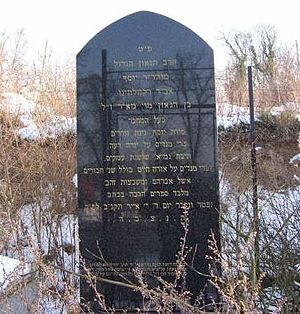| Revision as of 11:00, 15 November 2023 editFintor (talk | contribs)Autopatrolled, Extended confirmed users, Pending changes reviewers21,809 editsm →Works← Previous edit | Revision as of 11:04, 15 November 2023 edit undoFintor (talk | contribs)Autopatrolled, Extended confirmed users, Pending changes reviewers21,809 edits →Works: full textNext edit → | ||
| Line 20: | Line 20: | ||
| ==Works== | ==Works== | ||
| ] | ] | ||
| Rabbi Teomim's ''Pri Megadim'' |
Rabbi Teomim's ''Pri Megadim'' | ||
| (פרי מגדים, | |||
| <ref>]</ref> | <ref>]</ref> | ||
| published 1782) | published 1782) | ||
| is a widely referenced work on the '']''. | is a widely referenced work on the '']''. | ||
| It is composed, essentially, as a ] on | It is composed, essentially, as a ] on ] there: | ||
| ] there: | |||
| On the '']'' section, | On the '']'' section, | ||
| ''Mishbetzot Zahav'' discusses ]'s '' |
''Mishbetzot Zahav'' discusses ]'s ''Turei Zahav,'' | ||
| and ''Eshel Avraham'' is on ]'s ''Magen Avraham''. | and ''Eshel Avraham'' is on ]'s ''Magen Avraham''. | ||
| On the ] section, ''Siftei Da'at'' discusses ]'s ''Siftei Kohen'', and ''Mishbetzot Zahav'' is continued. | On the ] section, ''Siftei Da'at'' discusses ]'s ''Siftei Kohen'', and ''Mishbetzot Zahav'' is continued. | ||
| ''Pri Megadim'' is however seen as authoritative in its own right, often quoted, for example, by the ]. | ''Pri Megadim'' is however seen as authoritative in its own right, often quoted, for example, by the ]. | ||
| (The is available on | |||
| ].) | |||
| Teomim also authored: | Teomim also authored: | ||
Revision as of 11:04, 15 November 2023
Galician rabbi (1727–1792)
Joseph ben Meir Teomim (1727–1792; Hebrew: יוסף בן מאיר תאומים) was a Galician Rabbi. He was one of the foremost Torah Scholars of his time, a "thorough student of rabbinical literature, and... not unlearned in the secular sciences". He is also referenced as "The Pri Megadim", for his best known work.
Biography
Teomim was born in Shchyrets, then in Poland (today in Ukraine). His father, Rabbi Meir Teomim, became Dayan (rabbinic judge) and Rosh Yeshiva in Lemberg (Lvov), and the family moved there.
Teomim studied Torah, primarily under his father, in the Lvov yeshivah; while still young he took up a position as "preacher and rabbinical instructor" there. At the age of 20 he moved to Komarno to marry. He spent more than a decade there primarily studying and writing, and also working as a melamed.
In 1767, on the invitation of Daniel Itzig, he went to Berlin to co-head a Yeshiva with Rabbi Hirschel Levin. Following his Father's death in 1771, Teomim returned to Lemberg, eventually becoming Dayan there. In 1782 was appointed Rabbi at Frankfurt an der Oder, where he remained until his death.
He was buried in the Jewish cemetery at Frankfurt/Oder.
Works

Rabbi Teomim's Pri Megadim (פרי מגדים, published 1782) is a widely referenced work on the Shulkhan Aruch. It is composed, essentially, as a supercommentary on the major commentators there: On the Orach chayyim section, Mishbetzot Zahav discusses David ben Samuel's Turei Zahav, and Eshel Avraham is on Avraham Gombiner's Magen Avraham. On the Yoreh De'ah section, Siftei Da'at discusses Shabbethai Kohen's Siftei Kohen, and Mishbetzot Zahav is continued. Pri Megadim is however seen as authoritative in its own right, often quoted, for example, by the Mishna Berurah. (The full text is available on wikisource.)
Teomim also authored:
- Porat Yosef, novellæ on Yebamot and Ketubot, with rules for halakhic decisions (Zolkiev, 1756)
- Ginnat Vradim, seventy rules for the comprehension of the Talmud (Frankfort-on-the-Oder, 1767)
- Tebat Gome, on the Sabbatical sections (Frankfort-on-the-Oder, 1782)
- Shoshanat ha-'Amakim, a methodology of the Talmud, published together with the preceding
- No'am Megadim, commentaries on the prayers, published with the prayer-book Hegyon Leb.
- Rosh Yosef, novellæ on Berachos, Shabbos, Pesachim, Beitzah, Megillah, and Chullin
He left two works in manuscript: Sefer ha-Maggid, a commentary on the Torah and the Haftarot, sermons for Shabbat and festivals, and a twofold commentary on Pirke Avot; and Em la-Binah, a Hebrew, Talmudic Aramaic, and Biblical Aramaic lexicon. In the introduction to the latter, Rabbi Te'omim mentions a great number of his writings on halakhot and ethics, which are no longer in existence.
Bibliography and references
![]() This article incorporates text from a publication now in the public domain: Singer, Isidore; et al., eds. (1901–1906). "TE'OMIM, JOSEPH BEN MEÏR". The Jewish Encyclopedia. New York: Funk & Wagnalls. Retrieved 14 Mar 2012.
This article incorporates text from a publication now in the public domain: Singer, Isidore; et al., eds. (1901–1906). "TE'OMIM, JOSEPH BEN MEÏR". The Jewish Encyclopedia. New York: Funk & Wagnalls. Retrieved 14 Mar 2012.
The following bibliography is referred to in the Jewish Encyclopedia article:
- D. Cassel, in Ersch and Gruber, Encyc. section ii., part 31, p. 97;
- Steinschneider, Cat. Bodl. col. 1534;
- Neubauer, in Ha-Maggid, xiii. 285;
- Fuenn, Keneset Yisrael, p. 514;
- Buber, Anshe Shem, p. 95.
This biographical article about a Polish rabbi is a stub. You can help Misplaced Pages by expanding it. |
This biographical article about a German rabbi is a stub. You can help Misplaced Pages by expanding it. |
This biographical article about a person notable in connection with Judaism is a stub. You can help Misplaced Pages by expanding it. |
- See He: יוסף_תאומים for detail
- He: פרי_מגדים
- Neubauer, Cat. Bodl. Hebr. MSS. No. 1500